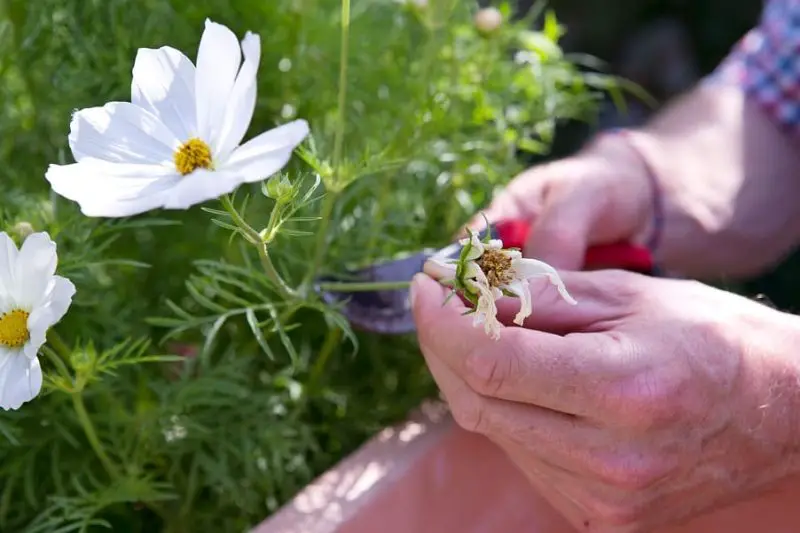If you want your cosmos to bloom endlessly through the warm months, mastering the art of deadheading is the key. Cosmos are cheerful, sun-loving flowers that thrive on regular care, and deadheading plays a huge part in extending their beauty. This simple gardening task keeps the plant from putting energy into seed production, allowing it to focus on creating more blooms instead. It’s one of the easiest ways to keep your garden full of color and your cosmos healthy from spring to fall.
Deadheading cosmos isn’t just about appearances—it’s about plant health and vitality. When done correctly, it can transform a fading plant into a stunning, continuous display of flowers. Gardeners who skip this step often notice fewer blooms and a tired-looking plant by midsummer. But with a bit of attention and the right timing, your cosmos will reward you with weeks of fresh blossoms that brighten your garden. This guide will walk you through everything you need to know about how to deadhead cosmos for a healthier, more vibrant display.
What Is Deadheading and Why It Matters

Deadheading is the gardening practice of removing spent or fading flowers. It encourages continuous blooming and healthier growth. For cosmos, this technique is especially valuable. The plant naturally shifts its energy toward producing seeds once flowers begin to die. Cutting off withered blooms prevents the plant from wasting energy on seed development. That energy is reinvested in creating new flower buds. The result is a much longer flowering season filled with vibrant, fresh blossoms that brighten beds and borders.
This process is not only about aesthetics. It also directly improves the health and vigor of your cosmos plants. When you allow the flowers to dry and set seed, the plant becomes exhausted and produces fewer blooms. Regular deadheading promotes steady growth, stronger foliage, and better resistance to common diseases. It helps maintain an even shape and prevents the plant from becoming leggy or sparse. With consistent attention, cosmos stay bushy and attractive rather than tall and thin.
Another essential reason for deadheading is to manage self-seeding and garden order. Cosmos are prolific seed producers and can spread across beds without control. While some gardeners welcome this natural reseeding, many prefer planned placement. Removing spent flowers means you choose where new plants appear next season. Deadheading is a quick and simple task that requires only minutes each week. It boosts flowering potential. It improves garden aesthetics and reduces unwanted seedlings. Deadheading is a small effort with big returns for most home gardeners. A weekly glance through your beds keeps plants tidy and rewards you with continual color all season. Try it this season.
When to Deadhead Cosmos (Timing for Best Results)
The best time to deadhead cosmos is as soon as the flowers begin to fade, wilt, or lose their vibrant color. Once petals start to curl or drop, it signals that the bloom has completed its reproductive stage. Acting quickly at this point prevents the plant from shifting its energy toward seed formation. Instead, that energy is redirected into creating new flower buds, resulting in a longer, more colorful blooming season. If you regularly remove faded blooms, your cosmos will continue flowering from early summer right up until the first frost. A good habit is to check your cosmos every two to three days to catch declining blooms early.
The frequency of deadheading depends on both your local climate and the maturity of your plants. In warmer regions where blooms appear rapidly, deadheading may need to be done every few days. In cooler climates or when the plant is still developing, once-a-week deadheading is usually enough. The key is consistency—cosmos respond best to steady care. Leaving too many spent blooms at once can cause the plant to slow down its production. For best results, perform deadheading in the morning when the air is cool and the stems are firm, making cuts cleaner and less stressful for the plant.
As the growing season nears its end, timing becomes a strategic choice. Gardeners who want cosmos to self-seed can allow the last wave of flowers to dry and set seed naturally. Those who prefer extended color should continue removing old blooms until frost. Balancing these approaches helps you control both appearance and reseeding. With practice, you’ll find the perfect rhythm that keeps your cosmos lush, productive, and blooming beautifully season after season.
Tools and Materials Needed for Deadheading Cosmos
To deadhead cosmos effectively, having the right tools makes the process smoother and safer for the plant. The most essential tool is a pair of clean, sharp pruning shears or scissors. Dull blades can crush the stems rather than cutting them cleanly, leading to damage and slower healing. For smaller or more delicate plants, you can even use your fingers to pinch off the faded blooms, but only if the stems are soft. A small garden bucket or container is also useful to collect the spent flowers and keep your workspace neat. This helps prevent fallen petals from attracting insects or harboring disease near your garden beds.
Keeping your tools clean is just as important as using them correctly. Always disinfect your shears before and after use with rubbing alcohol or a mild bleach solution. This step prevents the spread of fungal infections or bacterial diseases that can travel from one plant to another. A pair of lightweight gardening gloves can also protect your hands from scratches, especially if you’re working with multiple plants or dense foliage. Gloves with a snug fit allow for better precision when handling stems and buds. Comfort is key, as deadheading may take time when you have a large garden filled with cosmos.
Another useful item to keep nearby is a small watering can or hose with a fine mist setting. After deadheading, a light watering helps the plant recover from the trimming process and encourages new growth. Adding a bit of compost or a balanced liquid fertilizer once a month also strengthens the plant, helping it produce even more blooms. With a few reliable tools and simple maintenance habits, you can keep your cosmos garden thriving beautifully all season long.
How to Deadhead Cosmos Properly (Step-by-Step Process)
Deadheading cosmos is a simple but precise task that rewards careful attention. The first step is to identify which flowers are ready for removal. Look for blooms that have lost their color or have petals that are starting to shrivel or dry at the edges. These are the flowers that have completed their blooming phase and will soon produce seeds. Hold the stem just below the faded flower head and trace it down to the first set of healthy leaves or a new bud. Use clean, sharp pruning scissors or your fingers to snip the stem just above that node. This encourages new branches to grow and ensures more blooms in the coming weeks.
After removing faded blooms, it’s important to inspect the plant’s overall structure. Sometimes, deadheading offers the opportunity to tidy up the plant by removing any weak or crossing stems. This helps improve airflow, reduces the risk of fungal issues, and keeps the cosmos bushy and balanced. Always handle the plant gently, as cosmos stems are delicate and can snap easily. Dispose of the removed flowers and stems away from your garden to avoid attracting pests or diseases. Clean your pruning tools after each session to prevent the spread of bacteria or mold between plants.
If your cosmos has become tall or leggy, combine deadheading with light pruning. Trim back overly long stems by a few inches to encourage side shoots and denser growth. This method rejuvenates the plant and promotes more flowering points along each stem. Be consistent throughout the growing season—deadhead and trim lightly rather than waiting for the plant to become overgrown. With each careful cut, you stimulate new life, ensuring your cosmos remains vigorous and full of radiant blooms until the end of the season.
Post-Deadheading Care for Cosmos
After deadheading, cosmos plants benefit from gentle but consistent aftercare to recover and produce new blooms quickly. The first step is to give your plants a light watering right after you finish trimming. This helps reduce stress and keeps the soil evenly moist, allowing the plant to channel energy into new growth. Cosmos prefer well-draining soil, so avoid overwatering, which can lead to root rot. Water at the base of the plant rather than overhead to keep the foliage dry and prevent fungal diseases. Adding a thin layer of organic mulch around the base can also help retain moisture and regulate soil temperature, especially during hot weather.
In the days following deadheading, monitor your plants closely for signs of new buds. Once new growth appears, it’s a good time to feed your cosmos with a balanced, water-soluble fertilizer diluted to half strength. Over-fertilizing, however, can encourage leafy growth at the expense of flowers, so moderation is key. If your soil is already rich, compost or organic matter is often enough to provide nutrients. Deadheading combined with light feeding keeps your cosmos productive and vibrant. Pruning any weak or crowded stems at this stage will also improve airflow, helping the plant stay strong and disease-free.
Cosmos thrive best when they receive full sun and regular attention throughout the growing season. After each round of deadheading, continue to remove yellowing leaves or damaged stems to maintain the plant’s health and tidy appearance. As the season progresses, you can repeat this care routine every two to three weeks to sustain flower production. With proper post-deadheading care, your cosmos will respond with renewed vigor, covering your garden in waves of soft, colorful blossoms that last right up to the first frost.
How Deadheading Affects Cosmos Growth and Bloom Cycle
Deadheading has a profound effect on the way cosmos plants grow, bloom, and sustain themselves through the season. When flowers fade and are left on the plant, they trigger the natural seed-forming process. This shift signals to the cosmos that its reproductive goal is complete, slowing or even stopping new flower production. By removing spent blooms, you interrupt this signal, forcing the plant to stay in a continuous growth and flowering phase. Essentially, deadheading “tricks” the cosmos into believing it still needs to reproduce, so it keeps generating new buds instead of diverting energy toward seeds.
This redirection of energy greatly influences the overall vigor of the plant. Instead of exhausting itself on seed development, the cosmos channels nutrients and moisture toward leaf and bud production. You’ll notice healthier stems, richer foliage, and more frequent blooming cycles when deadheading is done consistently. The plant remains fuller and denser rather than tall and spindly, as trimming encourages lateral branching. Each cut stimulates new growth points, leading to a wider and more balanced shape that can support more blossoms at once. Over time, this creates a lush, vibrant display that transforms your garden into a field of color.
In addition to improved flowering, deadheading enhances the longevity and resilience of the cosmos plant. It reduces stress by maintaining a steady rhythm of growth and bloom, preventing the sudden decline that often happens when seed production takes over. This continuous cycle of renewal keeps the plant active and vigorous well into late autumn. With each round of deadheading, the cosmos reinvests in itself—growing stronger, producing more buds, and maintaining its cheerful blooms far longer than neglected plants.
How Often Should You Deadhead Cosmos?
The frequency of deadheading cosmos largely depends on how quickly your plants bloom and fade, which is influenced by the weather, variety, and growing conditions. In general, cosmos should be deadheaded every few days during peak blooming season. This is when flowers open rapidly and begin to fade just as quickly. Regular attention prevents the plant from wasting energy on seed development and keeps the blooming cycle active. For small gardens or potted cosmos, a quick check two to three times per week is often enough to catch fading flowers early and remove them before they dry completely.
In larger garden beds, deadheading can become part of a simple weekly routine. Setting aside a few minutes once a week to inspect your cosmos patch helps maintain their continuous beauty without overwhelming your schedule. If the weather is hot and dry, blooms may fade faster, meaning you might need to deadhead more often to keep up. Conversely, during cooler or rainy periods, flowers last longer, allowing you to stretch the interval between deadheading sessions. The key is observation—cosmos will tell you when it’s time, as fading petals and browning centers are easy to spot among fresh blossoms.
Regularity in deadheading creates a rhythm that your plants respond to. The more consistently you remove old blooms, the more vigorous and abundant the new flush of flowers will be. Cosmos thrive on gentle, steady care rather than sporadic attention. When deadheaded frequently, they maintain dense foliage, strong stems, and vibrant color throughout the season. Over time, this routine becomes second nature, turning what seems like a small garden task into a powerful tool for healthier, more productive cosmos plants that reward you with endless summer color.
How Weather and Environment Affect Deadheading Results
Weather and environmental conditions play a major role in how cosmos respond to deadheading and how long they continue to bloom. These plants thrive in warm, sunny conditions, so regions with consistent sunlight often see faster regrowth and more frequent blooming cycles after deadheading. When temperatures stay between 70°F and 85°F (21°C to 29°C), cosmos recover quickly, sending out new buds within days. However, when exposed to extreme heat, the plants may slow their growth and require extra care. Providing afternoon shade during heat waves helps reduce stress and allows cosmos to focus their energy on producing more blooms instead of survival.
Moisture levels also influence how effective deadheading will be. Cosmos prefer well-draining soil and moderate watering. In humid or rainy conditions, the removed flower heads and stems can decompose more slowly, attracting pests or fungi if not cleared away properly. After deadheading in such climates, it’s wise to ensure good airflow around the plants and avoid overhead watering. In dry environments, maintaining a light mulch layer around the base helps retain soil moisture and prevent wilting after trimming. Balanced moisture, combined with regular deadheading, keeps cosmos healthy and less prone to disease, ensuring they continue blooming beautifully.
Environmental factors like soil fertility and wind exposure also affect the plant’s recovery after deadheading. In poor soils, adding compost or a light organic fertilizer once a month helps the plant replenish lost nutrients. Windy locations can cause stems to bend or break, so staking taller varieties may be necessary. Creating a stable growing environment gives cosmos the best chance to flourish after every trimming. With a balance of sunlight, water, and protection, your cosmos will respond to deadheading with renewed strength and a profusion of flowers that last through the season.
Encouraging Continuous Blooming After Deadheading
Keeping cosmos blooming continuously after deadheading requires consistency and care. Once the spent flowers are removed, the plant quickly begins producing new buds, but it still needs support to sustain that momentum. The most effective way to encourage ongoing blooming is to provide steady sunlight, moderate watering, and nutrient balance. Cosmos thrive in full sun—at least six to eight hours per day. Without enough light, they may grow tall and weak instead of full and floral. After each round of deadheading, give your cosmos a light watering to refresh the soil and help the plant recover. A dry period following trimming can slow new growth, while overly wet conditions may lead to rot, so aim for balanced moisture.
Feeding your cosmos properly also plays a key role in maintaining continuous blooms. Avoid fertilizers that are high in nitrogen, as they encourage leaf growth rather than flowers. Instead, use a balanced or slightly phosphorus-rich fertilizer once every four to six weeks to promote steady flowering. Compost or organic matter added around the base of the plant can serve the same purpose, enriching the soil gradually. Combining this with regular pruning of weak stems and leaves ensures that nutrients are directed toward healthy, blooming areas. When your cosmos stay well-fed and tidy, they reward you with strong stems and waves of vibrant blossoms.
Finally, consistency is the secret to success. Continue inspecting your cosmos throughout the growing season, even when the garden looks at its best. Remove faded blooms promptly, tidy up stray stems, and monitor for any signs of stress. This routine keeps the plant active and prevents dormancy. With this rhythm of care, each round of deadheading and maintenance extends the life and beauty of your cosmos. The reward is a continuous, dazzling sea of flowers that lasts from the height of summer until the first touch of frost.
Common Mistakes to Avoid When Deadheading Cosmos
Cutting Too Low on the Stem
One of the most common mistakes gardeners make when deadheading cosmos is cutting too low on the stem. Trimming too close to the base or below a healthy node can remove potential new growth points and weaken the plant’s structure. Cosmos produce new buds from the leaf joints, so cutting below them eliminates the chance for regrowth. Instead, always locate the first pair of healthy leaves or a small developing bud below the spent flower, and make a clean cut just above it. This technique encourages branching and ensures that new blooms appear faster and in greater numbers.
Another risk of cutting too low is leaving the plant vulnerable to stress and disease. Deep cuts create larger wounds that take longer to heal, allowing moisture and bacteria to enter. Over time, repeated deep pruning can cause the stems to become woody or brittle. To avoid this, use sharp, clean scissors or pruners and make gentle, precise cuts. With the right approach, your cosmos will recover quickly and continue producing fresh blooms without interruption throughout the growing season.
Neglecting to Deadhead Regularly
Irregular deadheading is another mistake that limits the blooming potential of cosmos. When old flowers are left on the plant too long, it begins to shift its focus toward seed production instead of generating new buds. This natural process signals that the plant’s blooming phase is over, resulting in fewer flowers and reduced energy for future growth. Consistent deadheading keeps the plant in a perpetual flowering state, ensuring a continuous display of color through the season. Regular attention every few days can make the difference between a few sparse blooms and a garden full of vibrant blossoms.
Inconsistent deadheading can also cause the plant to become unbalanced or leggy. As some parts continue to bloom and others dry out, the plant diverts energy unevenly. Over time, this can lead to weaker stems and fewer lateral branches. By developing a simple schedule—such as checking your cosmos twice a week—you can maintain their rhythm and health easily. Regular deadheading doesn’t take long but offers long-term rewards in stronger growth and non-stop flowering.
Leaving Debris Around the Plant
Leaving dead flowers and plant debris on the soil after deadheading may seem harmless, but it can invite a range of problems. Fallen petals and stems often trap moisture, creating ideal conditions for fungal diseases like powdery mildew or gray mold. These decaying parts can also attract pests such as aphids and thrips, which thrive in damp, organic matter. To keep your cosmos healthy, always collect and remove the spent blooms immediately after cutting. Disposing of them in a compost bin or garden waste pile away from your flower bed helps maintain cleanliness and prevents the spread of disease.
A clean growing area also promotes better airflow around the cosmos plants. Good air circulation dries out moisture faster and reduces the risk of leaf spots or rot. After cleaning up, lightly mulch the base of the plant to regulate temperature and retain soil moisture. This small habit goes a long way in keeping your garden tidy and your cosmos thriving. Deadheading should always include both cutting and cleaning—two steps that together preserve the beauty and strength of your plants all season long.
FAQs About Deadheading Cosmos
Conclusion
Deadheading cosmos is the key to keeping your garden vibrant and full of color all season long. By removing faded blooms, you encourage fresh growth, stronger stems, and endless waves of flowers. This simple act transforms tired plants into thriving, blooming displays that last until frost. With consistent care, sunlight, and gentle trimming, your cosmos will reward you with beauty that never fades. Every cut renews its life and energy—reminding us that in gardening, small actions bring lasting rewards and endless blossoms. Keep deadheading, and your cosmos will never stop blooming.






